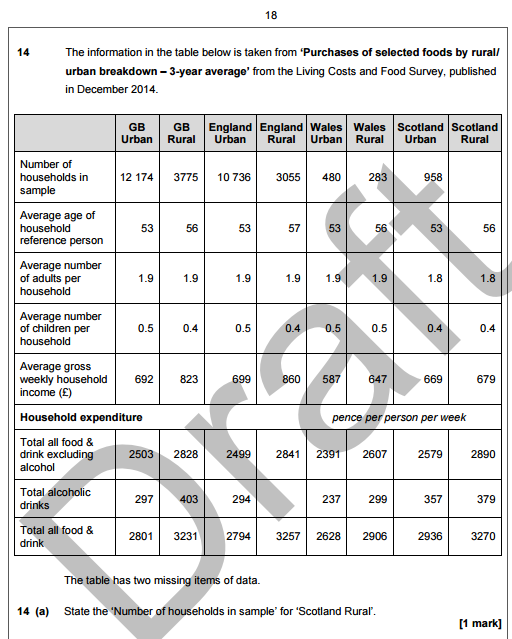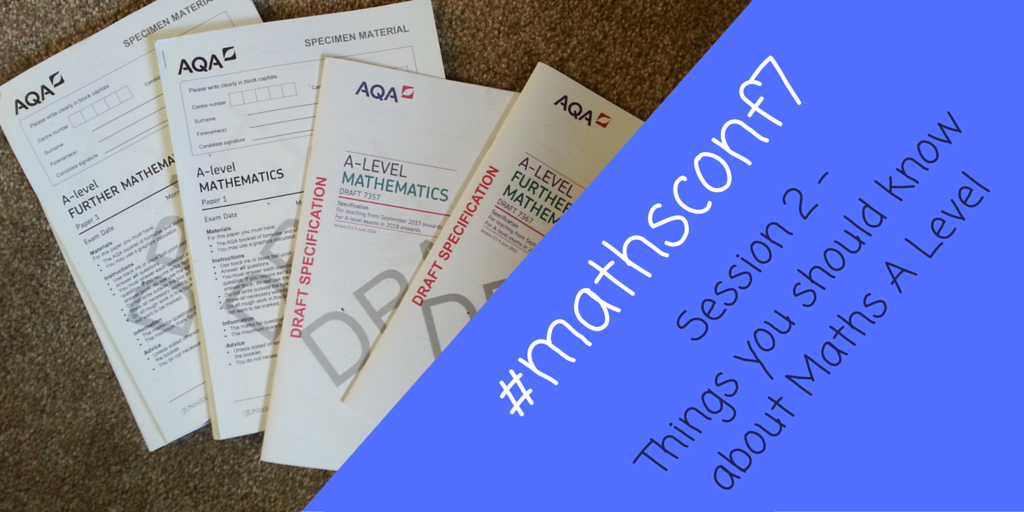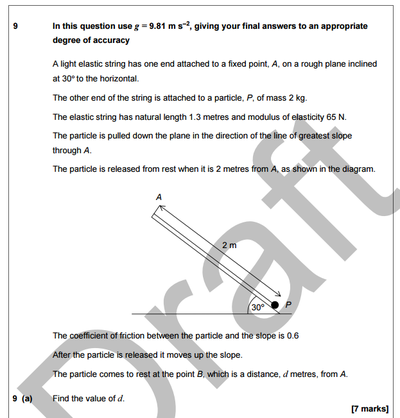Session 2 at #MathsConf7 was delivered by Christine Andrews, Andrew Taylor and Gary Wing, and looked at the developments and questions about the new Maths A Level for AQA. This blog is just my interpretation of their workshop, and shouldn’t be taken as gospel, although I’ve tried to reproduce accurately what was said. It’s also worth remembering that these materials are still in draft form, and have not been accredited by Ofqual yet.
The session looked at many more than the titular 10 issues, and provided a lot of food for thought – I’m looking forward to teaching the new A Level, but it will be hard to mentally move away from the modular system.
Teaching and examining using the “large data set”
Many of the Statistics questions will now be based on a “large data set”; AQA have chosen Family Food, which is published by the Office for National Statistics every December. Christine clarified that this selection would not change through the lifetime of the specification, but that the updated version would be used every year, and examination questions would be set using the most recent set of data; I took this to mean that exams in summer 2018 would use data published at the end of 2016. Christine also highlighted that teaching using the data set would not be compulsory, but that familiarity with the scenarios and language used would be advantageous in an exam situation (see example below: Paper 2, Q14 from the AS Level papers, available here). This approach would certainly make the teaching of statistics more coherent, and give lots of time for real in-depth analysis of one problem, as opposed to skimming over the surface of many different scenarios. Gary highlighted the opportunities to investigate these data further using technology such as Excel and MatLab.

Use of calculators; are pupils expected to purchase/use a graphical calculator?
Calculators used for the new specification materials are expected to have an iterative function and standard statistical calculations. The normal and binomial tables will no longer be provided in the formula booklet, so pupils will need to be familiar with use of calculators for these topics. Gary said that more reasonably-priced calculators are currently being developed, but we have no idea when these will hit the market.
Use of the equation solver on a calculator will be credited in the mark scheme if used well – such as using a calculator to solve a quadratic at the end of a mechanics problem (see examples below, Paper 3 Mechanics, Q9 from A Level Further, available here and Paper 3, Q4b alternative solutions from A Level). In such scenarios, the final solution would be worth one mark, and pupils are expected to use their calculators to do this; any marks for calculations like this have now gone.
Pupils should use the wording of the question as an indicator of whether a calculator solution is appropriate; “show that” would require pupils to demonstrate their method without using a calculator.
With regards to graphical calculators, Texas apparently have one out now and Casio are aiming to produce one by the end of November.
For Further Mathematics, calculators are also required to compute using 3×3 matrices. Gary highlighted that pupils studying FM may well want to invest in a graphical calculator, but Christine clarified that AQA would ensure that those who didn’t have graphical calculators would not be disadvantaged in an exam.
Further Maths Paper 3 – choosing options
Andrew clarified that pupils should not attempt all three papers (Discrete, Mechanics, Statistics) in a timed exam, as this would disadvantage pupils. The decision about which papers to sit would be made at the point of entry, and is not a choice on exam day. Pupils sitting the exam will get the correct two papers out of three and use the examination time to answer these two papers.
Curriculum planning for AS Mathematics, A Level Mathematics and Further Mathematics
The AS and A Level are not linked (so results in AS will not count towards the final A Level qualification), but they are co-teachable.
When delivering A Level Mathematics and Further Mathematics, it’s possible to deliver either side-by-side or in sequential order. AQA has permission to offer examinations for A Level Maths after the first year of teaching, so pupils could sit the full A Level after the first year, then sit Further Mathematics in the second year.
AS Further Maths will only require content from AS Maths, with the exception of radian measure, and can also be sat in June 2018.
Weighting of Pure and Applied in AS and A Level
Both A Level Mathematics and A Level Further Maths are weighted 2/3 Pure, 1/3 Applied – in the case of the single A Level, this is essentially 1/6 Mechanics and 1/6 Statistics.
AS Further Maths is weighted approximately 50/50. 50% of the content is prescribed and focuses on pure mathematics – Andrew explained that this had come from end-users such as universities and industry, who prefer confidence with pure mathematics over applications. There is a small amount of prescribed mechanics (simple and damped harmonic motion for application of differential equations). AS Further Mathematics offers more opportunity for pupils to study Mechanics and Statistics in more depth without completing the full A Level FM.
Topics appearing on certain papers
Papers will become more like GCSE, where any topic can be examined on any paper. This has been done to avoid fragmenting the A Level and providing pupils with a more holistic experience. Emphasis should be on developing a body of mathematical knowledge rather than learning particular topics for particular papers.
Textbooks
Textbooks are being produced by Cambridge, Oxford and Hodder, for (hopeful) publishing next spring. These depend on accreditation of specification materials. AQA plan to only endorse those that produce a full range of texts for Maths and Further Maths.
Practice papers and resources
AQA plan to produce comprehensive teaching guidance and a route map for teaching the new specifications. There will also be two additional sets of specimen papers, one after accreditation and one secure set early 2018, and a set of topic tests and an eLibrary of resources.
When this was published on my old site, AQA added the following comment:
Thanks for this great summary Miss Norledge, we’re glad to hear you’re looking forward to teaching the new linear A-levels.
We thought we’d add a little more information where it’s possible we didn’t go into sufficient depth in the 50 minute session on the day.
Data set: The Subject Criteria (https://www.gov.uk/government/publications/gce-as-and-a-level-mathematics) from the Department for Education requires students to “become familiar with one or more specific data set(s) in advance of the final assessment”, so while it is not compulsory to use the data set in your teaching, the GCE Subject level guidance for Mathematics document (https://www.gov.uk/government/publications/gce-subject-level-guidance-for-mathematics) published by Ofqual states “questions/tasks should be likely to give a material advantage to learners who have studied, and are familiar with, the prescribed large data set.”
Curriculum planning: For AS Further Maths, as well as radian measure, students will also require compound angle formula from the A-level Maths content.
Weighting: AS Maths is also weighted 2/3 pure and 1/3 applied. The inclusion of simple and damped harmonic motion in the compulsory content is only on the A-level Further Maths, not included in the AS.
If readers would like any further information about the new A-levels in Maths and Further Maths from AQA, you can email us maths@aqa.org.uk or call us on 0161 957 3852.


